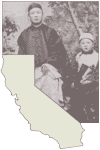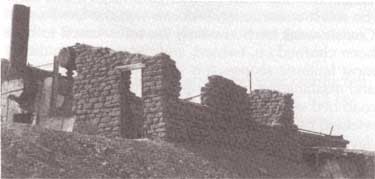![]()

Five Views: An Ethnic Historic Site Survey for California
MENU
Introduction
Early Contacts
1850s
1860s
1870s
1880s
1890s
1900s
Historic Sites
Selected References

A History of Chinese Americans in California:
HISTORIC SITES
Harmony Borax Works
Furnace Creek, Inyo County
At present, the Harmony Borax Works plant consists of a four-level ruin located on a hillside in Death Valley. There are remains of buildings, machinery, tanks, piping, and waste tailings. In addition to the plant, a nearby townsite contains remnants of buildings and trash dumps relating to the company settlement. A 20-mule team wagon is near the plant.
Originally, the four terraces were supported by cut sandstone, cobble rubble, or wood plank retaining walls. Adjacent to the service road, on the upper most tier of the plant, were placed two large, rectangular dissolving tanks of iron. East of the dissolving tanks, on a slightly lower level, an adobe structure was built to house the boiler and to serve as a machine room. Wood to fuel the boiler was stored in the area east of the adobe structure. The west side of the plant was reserved as a skimming pile.
The next two levels down the hill contained square metal tanks housed in wood. Near these tanks and the dissolving tanks above were rail tracks for ore cars. The bottom level of the plant contained several long rows of crystallizing vats with truncated cone shapes and a barn-like wooden structure for storage.
After borax was found near Furnace Creek Ranch (then called Greenland) in 1881, W. T. Coleman built the Harmony plant and began to process ore in late 1883 or early 1884. When in full operation, the Harmony Borax Works employed 40 men, who produced three tons of borax daily. What little evidence remains indicates that the bulk of this labor force was composed of Chinese workers. The Chinese laborers gathered the impure chunks of mineral from the valley floor and loaded them into one-horse carts for transport to the borax plant.
Because of the extreme heat during the summer months, Coleman moved his work force to the Amargosa Borax Plant near present-day Tecopa, California. The Harmony operation became famous through use of large mule teams and double wagons, which hauled borax over the long route to Mojave.
When the road from Harmony to Mojave was built, the worst construction problem was the Devil's Golf Course — salt beds in which the soil seemed to have been churned up, twisted, and contorted into the most fantastic shapes. It is said that breaking down and mashing the irregularities to make a smooth road bed was done entirely with sledgehammers wielded by Chinese laborers who were paid $1.25 a day. They were taken from their regular work of collecting "cotton balls" (borax) from Harmony marsh.
By 1900, after the peak of development of the borax industry in Inyo County, there were still at least 64 Chinese Americans left in the county. Occupations included: cooks, railroad section laborers, gardeners, laundrymen, laborers, prospectors for soda, mer chants, a peddler, a laborer in a flouring mill, a restaurant keeper, and a waiter. There were six women (five wives and one housekeeper) and four children.
Harmony Borax Works is listed on the National Register of Historic Places and as a California State Historical Landmark.

Harmony Borax Works, Furnace Creek, Inyo County
NEXT> Hercules Powder Plant
Last Modified: Wed, Nov 17 2004 10:00:00 pm PDT
http://www.cr.nps.gov/history/online_books/5views/5views3h40.htm
![]()
 Top
Top